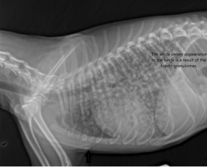Spike came to visit mid-summer for being a little down in the dumps and for a possible eye infection, as his left eye was red and squinty. He had a low grade fever, and it was clear his left eye was very uncomfortable. The pressure in his eye did not indicate glaucoma, but his vision was questionable and the back of the eye was not visible with an ophthalmoscope.
There was no history of trauma, and his blood work was pretty uneventful. His right eye looked normal at this visit.We collected a urine sample to test for a disease called blastomycosis. Unfortunately, this test takes 3-7 days to get the results and we were concerned that Spike’s eye problem was progressing quickly. Eyes are amazing things. There are so many things that work together to make vision happen! The eye can heal pretty quickly, but it can also go downhill just as quickly. For that reason, we sent Spike for a visit with a veterinary ophthalmologist (yes veterinary medicine has many specialty fields….these veterinarians have gone through an additional 3-4 years of intense education to earn their specialty degrees).The ophthalmologist agreed that the biggest concern was blastomycosis, so aggressive treatment was initiated that day. Thank goodness we did, since by the next day, Spike began showing symptoms in his right eye as well. A few days later, the test came back positive for blastomycosis, and we were already a couple days ahead of the game….our treatment plan was on course.

Spike
What is Blastomycosis?
Blastomycosis is a disease in animals and people caused by the fungus Blastomyces dermatitidis. This fungal organism is present in most of the US, but more prevalent in areas along the Mississippi, Ohio, and Missouri river valleys….so pretty much everywhere in the Midwest. The fungal spores are present in soil rich in organic matter like decaying wood or animal waste, along with a moist soil. Most of the cases at Mill Creek Animal Clinic are linked to dogs spending time in the woods of Wisconsin. Retrievers and hunting dogs are more at risk…they have their noses to the ground A LOT! Excavated sites are risky, since there is overturning of the soil that allows the fungal organism to be at the surface.Blasto can affect several different areas of the body, but the most common sites are the lungs (from breathing the spores in), and then the spores go out to the rest of the body. The blasto fungus like the eyes, as 20-50% of dogs with blastomycosis have eye lesions and these can quickly lead to blindness. Blastomycosis can cause skin, bone, muscle and brain infections. Unfortunately, Blasto can progress VERY quickly. Blasto is treatable with antifungal medication. However, there are many cases that the disease is too advanced by the time we see the pet, and the medication can’t kick in quick enough to save the dogDogs with suspected cases of blastomycosis need a thorough workup to arrive at the diagnosis as quickly as possible. A full blood workup, chest x-rays and complete physical exam are essential. The urine test is the best confirmation test, and is currently done at a lab in Tennessee.

Blastomycosis
Back to Spike…
Spike responded quickly to the medication. His chest x-rays showed no sign of blasto lesions in his lungs, so it appeared that his disease was limited to his eyes. The disease had progressed too far in his left eye, and unfortunately, he most likely will not regain vision in that eye. His right eye improved immensely, and we are optimistic that he will retain vision in that eye. He will be given antifungal medication for at least 6 months, and we will be re-testing him periodically to make sure there is no recrudescence.
So how did he get this horrible disease?
Spike had not been traveling to any other areas, so we know that he was exposed to the fungus here in the Chicagoland area. His family had just put in a new patio in their back yard, so we suspect that the overturned dirt led to his exposure. The human members of the family will be discussing blastomycosis with their physician to watch for any signs that they may have the disease. It is highly unlikely for humans to catch blasto from an infected dog, but they can inhale the spores the same way the dogs can. To be safe, we caution people to practice good hygiene (wash hands before touching your eyes or mouth) after handling a dog with blasto, especially if they have open draining skin lesions.Spike continues to do well, and although he is blind in one eye, he is a success and will live a good quality life for years to come. If you suspect your pet might have blastomycosis, schedule an appointment with your veterinarian as soon as possible!
What's Next
Call us or schedule an appointment online.
Meet with a doctor for an initial exam.
Put a plan together for your pet.

